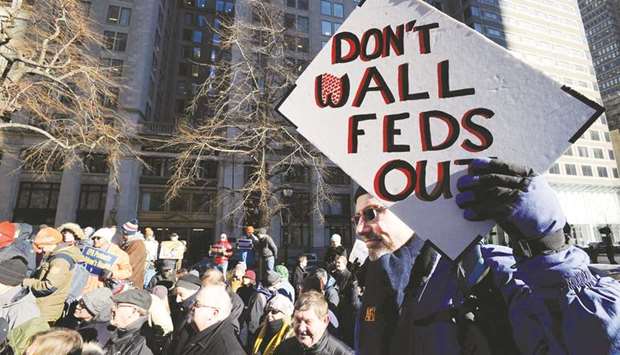US President Donald Trump said yesterday that he would not declare a national emergency for now as a way of ending a partial government shutdown and securing funds for a border wall, saying he would rather see the US Congress act.
Earlier, he appeared close to declaring a national emergency to bypass Congress and get funding for his Mexico-US border wall project in a political crisis that saw 800,000 federal employees go without paycheques.
After a meeting with Trump at the White House, his powerful Republican ally Senator Lindsey Graham tweeted: “Mr President, Declare a national emergency NOW. Build a wall NOW.”
Trump’s demand for $5.7bn to fund border wall construction has morphed from a crowd-pleasing campaign slogan to an epic political fight paralysing Washington, setting an ominous precedent for the remaining two years of the real estate magnate’s troubled first term.
Trump tweeted earlier that the situation on the Mexican border was “an invasion” and insisting that without a wall, “our Country cannot be safe. Criminals, Gangs, Human Traffickers, Drugs & so much other big trouble”.
However, unable to persuade Democrats to give him the money, Trump refused three weeks ago to sign off on a large chunk of unrelated government funding.
Yesterday that partial government shutdown hit the 21-day mark, equalling the record from previous funding freezes and marking the first day in the saga that paycheques failed to appear for workers as varied as Federal Bureau of Investigation (FBI) agents, air traffic controllers and museum staff around the country.
Trump hoped the shutdown would pressure Congress into giving him the wall money but the Democrats, who control the House of Representatives, haven’t budged, saying they won’t even discuss wall funding before government is fully reopened.
The impasse leaves Trump with few options other than to relent or to declare a national emergency on the Mexican border, giving himself authority to sidestep Congress and order wall funds to be squeezed from other budgets.
He appeared ever closer to taking the second option, which opponents say would likely be challenged in court as a case of presidential overreach.
On Thursday, Trump took his message to the Texas border with Mexico and insisted once more that he has “the absolute right to declare a national emergency”.
In preparation for the possible emergency move, the White House has asked the military to look into diverting funds currently allocated for disaster relief to the wall, US media reported – a move that would heighten the polemic.
The stand-off has turned into a test of political ego, particularly for Trump, who came into office boasting of his deal-making powers and making an aggressive border policy the keystone of his nationalist agenda.
Democrats, meanwhile, seem determined at all costs to prevent a president who relishes campaign rally chants of “build the wall!” from getting a win.
Both Democrats and Republicans agree that the US-Mexican frontier presents major challenges, ranging from the hyper-violent Mexican drug trade to the plight of asylum-seekers and poor migrants seeking new lives in the world’s richest country.
There’s also little debate that border walls are needed: about a third of the frontier is already fenced off.
But Trump has turned his push for more walls into a political crusade seen by opponents as a stunt to stoke xenophobia in his right-wing voter base, while wilfully ignoring the border’s complex realities.
Using typically polarising language, Trump spoke in McAllen, Texas, on Thursday of cross-border criminals pouring into the country to commit murder.
“They just go where there’s no security and you don’t even know the difference between Mexico and the United States,” he told a meeting of border patrol officers.
“They have women tied up, they have tape over their mouths, electrical tape. If we had a barrier of any kind, a powerful barrier, whether its steel or concrete ... we would stop it cold,” Trump said.
In fact, widely respected studies show that illegal immigrants generally commit fewer crimes than people born in the United States.
While some narcotics do enter the country across remote sections of the border, most is sneaked through heavily-guarded checkpoints, the government’s own Drug Enforcement Administration said in a 2017 report.
It said that most smuggling is done “through US ports of entry (POEs) in passenger vehicles with concealed compartments or commingled with legitimate goods on tractor trailers”.
Nancy Pelosi, the Democratic leader in the House of Representatives and a key figure in opposing Trump’s agenda, said money should be spent in many areas of border security, but not on walls.
“We need to look at the facts,” she said.

Government employee Hugh Martinez attends protest rally yesterday by government workers and concerned citizens against the government shutdown at Post Office Square in Boston.


